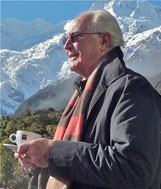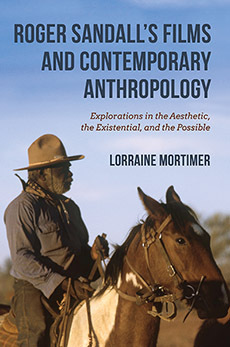The physical topography of central Australia is familiar — large areas of sandy semi-desert with rocky outcrops, waterholes, and caves. The religious topography of Aboriginal belief may be less well known, yet it can be easily understood since it was in many ways geographically indistinguishable: for each landscape feature there were associated spirit beings, many of them in roughly human form, whose activities had created those same rocks and waterholes and caves in the distant past. A map of central Australian religious topography therefore fits closely onto a map of the physical region as a whole.
Landscapes historically embodied time, memory, and the doings of ancestors. Within this triple incarnation the boundary between the living and the dead was somewhat vague. A large rock might mark where a totemic figure had died and “gone in” to the subterranean supernatural world of the dead; as such it was a kind of gravestone. But at the same time it represented that same figure materially transformed, permanently transfigured, invisibly sustained and animated by the life force of creation. If this metamorphosed being was touched, or rubbed against, or musically invoked — or if its name was recited or its totemic symbols displayed — all this could impart fresh vigor to the living. Every landscape was a vast array of such embodiments. In the words of Nancy D. Munn, “The number of ancestors is indefinite, and the objects they create constitute, in effect, the total, non-sentient environment as epitomized by the country itself.”
At ceremonial centers prominent landscape features were usually important. As for the function of the ceremonies, this was twofold. On the one hand they were often intended to promote the fertility of particular plants and animals — in one common designation they were “increase ceremonies” — and as such their purpose was economic. They helped to secure life’s daily necessities. For example, The Mulga Seed Ceremony shows activities meant to ensure the fertility of the mulga bush (Acacia aneura), while the events in Emu Ritual at Ruguri (Emu Ritual) are intended to increase the supply of emus, large ostrich-like birds found throughout Australia. Viewed in this light it might be said that the primary economic goal was to serve the material needs of the local totemic group. However, in the words of T. G. H. Strehlow, advantages coming to the local group were expected to benefit neighboring populations too:
…the members of kangaroo, euro, emu, carpet snake, grass seed, and other totemic clans were regarded as having the power of bringing about the increase of their totemic plants or animals not only within their local group areas, but throughout the adjoining regions as well.
Another purpose just as important as the first dramatized the escapades of mythical culture-heroes. Here the ceremonial point was more commemorative than economic. Designs painted on rock faces and cave walls recalled their doings; songs relating episodes in their travels celebrated their achievements. The painting of the designs was accompanied by continual singing, the atmosphere alternated between reverential, convivial, and enthusiastic, and the total experience had something of the “effervescence” that Durkheim (drawing on what he had read in Spencer and Gillen’s The Native Tribes of Central Australia) saw as an attractive emotional feature of communal religious rites.
What of the action? What does it mean and what is portrayed? The ancestral culture heroes are not merely commemorated; in song and dance their creative deeds and escapades are dramatically re-enacted in what W. E. H. Stanner calls “recapitulative mimes.” Thus it is that figures performing the dance of the Mulga Seed Men re-enact the travels of these mythical ancestors, while the paintings on the walls of Ruguri Cave pictorially recapitulate aspects of the travels of totemic Emu Men — the marks they left and the campsites they stopped at. These events too are partly transformative: by dramatic enactment the performers become for a while the Emu Men themselves, come to incarnate the past, and through a form of communion are reinvigorated. This theatrical aspect of the ceremony is important. Much discussion has taken place regarding the evolution of drama in a European context, usually in reference to its origins in Ancient Greece. But there is no logical reason why the recapitulative mimetic plays of Aboriginal Australia should not be tens of thousands of years older. The rudimentary elements of drama are story-telling, and the acting out of characters in a story, before an audience of one kind or another. Add to this a formal institutional setting and an audience a good deal larger than a domestic group sitting round a fire, and you have it. This suite of elements may be found in all the ceremonies here portrayed.
While a fair sample of scenes from Emu Ritual at Ruguri are presented here, we do not have anything from Walbiri Ritual at Gunadjari. But the sequence of events at the different religious sites was usually as follows. If rock-paintings were significant then the old and faded designs were first refreshed in order to restore their “totemic efficacy,” after which the younger men were brought to see and touch them in a form of initiation. This can be seen in Emu Ritual at Ruguri. Elsewhere the first activity was often the recovery of churinga from some hiding place. Usually consisting of long flat boards or oval stones incised with totemic designs, churinga were deeply revered religious artefacts. They have been described by L. R. Hiatt as “the religious property of one clan, and one only, and may be said to represent the clan’s existential essence.” As religious paraphernalia churinga symbolised a clan’s identity in much the same way national flags symbolise national identity in the modern world. The presentation of churinga to initiates, in a ceremony performed at dusk when a dozen neophytes both view and press themselves physically against them, occurs near the beginning of Pintubi Revisit Yumari. (Pintubi Revisit Yumari)
Two other forms of sacra were also prominent. One is a string cross; the other a larger structure also made of string called a wanigi. In both of them a stick or spear is used for a central armature, and slim horizontal cross-pieces (one in the case of the string cross; two in the case of the wanigi) provide additional elements upon which human-hair string is wound and stretched. Both were common items in central Australian ceremonies, various wanigi being illustrated in Spencer and Gillen’s 1899 classic The Native Tribes of Central Australia. The making and use of the string cross is shown in the finale of The Mulga Seed Ceremony. A sequence showing the making of wanigi appears in the video of Emu Ritual at Ruguri. The division of the tribal group into two moieties, noted in Stanner’s review, is a regular and intrinsic structural feature of such ceremonies. The moieties are referred to conventionally as the “owners” of the site, on the one hand, and the “managers” on the other — the latter being responsible for conducting the performance.
* * *
At the time the films were made in the late 1960s most of the men were living far from the sacred places where their ceremonies were actually performed. There were three main reasons for this — both voluntary and involuntary. From the late 19th century, pastoralists in search of grazing for sheep and cattle forced Aborigines off their land in Central Australia and drove them away from their ceremonial sites. As a result the status of affected indigenes became that of chronically displaced persons. Secondly, and in its long-term consequences more importantly, the irresistible attraction of free food and medicine, plus government efforts to “sedentarize” nomadic indigenes, led thousands of one-time desert dwellers to move to state-run settlements where these were available, converting independent hunters and gatherers into permanent welfare dependents.
Despite social dislocation and geographical displacement, however, the men retained an attachment to their tribal homelands. Moreover, those who had been born in a certain locality were expected to return to the totemic centers of their birthplace on ceremonial occasions. Combined with this was a sense of religious duty — a feeling that totemic responsibilities obliged them to perform their customary ceremonies no matter how far away they might be living. To enable them to revisit their sacred sites, often after a separation and absence of many years, the film-makers provided transport. A typical glimpse of a party of film-makers and performers en route is shown in the film Pintubi Revisit Yumari. Once arrived on location the men were encouraged to perform in a traditional manner using appropriate body-painting and ceremonial regalia. Beyond this their subsequent activities were largely spontaneous, the film-makers following events but not directing them.
Films: Emu Ritual, Pintubi Revisit Yumari, Yaru-Yaru, Mulga Seed Ceremony
Reading: Two essays by field-workers close to the material in the films, one of whom, T. G. H. Strehlow, witnessed similar ceremonies himself, can be found in Australian Aboriginal Anthropology (1970), edited by Ronald M. Berndt and published by the University of Western Australia Press. These are “Geography and the Totemic Landscape in Central Australia,” by T. G. H. Strehlow, and “The Transformation of Subjects into Objects in Walbiri and Pitjantjatjara Myth,” by Nancy D. Munn. A later book usefully surveying a number of issues in Australian Aboriginal ethnography is Arguments about Aborigines, Cambridge University Press (1996), by L. R. Hiatt.
* * *

 An Australian writer living in Sydney, Roger Sandall is the author of The Culture Cult (2001), a study of romantic primitivism and its effects. His work has appeared in a number of places including Commentary, The American Interest, Encounter, The New Criterion, The American, Sight and Sound, Quadrant, Art International, The New Lugano Review, The Salisbury Review, Merkur, Mankind, Visual Anthropology, and Social Science and Modern Society.
An Australian writer living in Sydney, Roger Sandall is the author of The Culture Cult (2001), a study of romantic primitivism and its effects. His work has appeared in a number of places including Commentary, The American Interest, Encounter, The New Criterion, The American, Sight and Sound, Quadrant, Art International, The New Lugano Review, The Salisbury Review, Merkur, Mankind, Visual Anthropology, and Social Science and Modern Society.